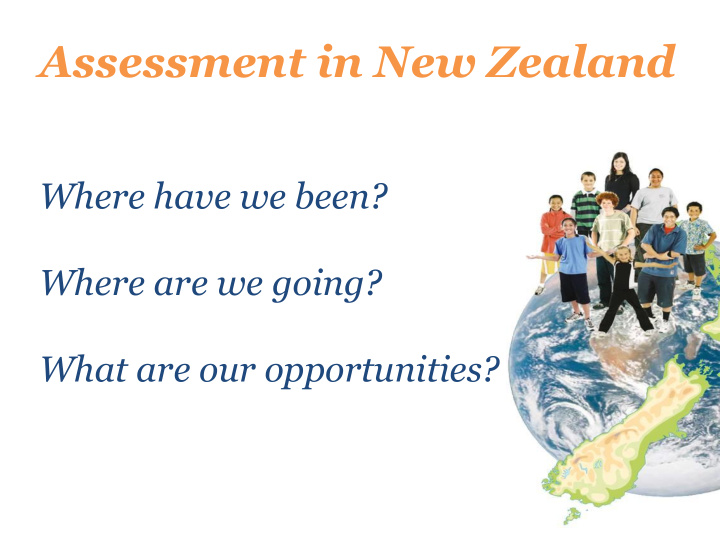



Assessment in New Zealand Where have we been? Where are we going? What are our opportunities?
Where would you find these statements? The primary purpose of assessment should be to provide information which can be used to identify strengths and guide improvement The primary purpose of assessment is to improve students learning and teacher teaching as both student and teacher respond to the information it provides A. New Zealand Curriculum (2007) B. Tomorrow Standards Report (1990) C. Directions for Assessment in NZ (2009) D. National Education Monitoring Project (1995)
Where have we been … where are we going? The primary purpose of assessment should be to provide information which can be used to identify strengths and guide improvement Tomorrows Standards 1990 The primary purpose of assessment is to improve students learning and teacher teaching as both student and teacher respond to the information it provides NZC 2007
Where have we been … 1989 MoE, ERO, NZQA established 1990 Tomorrows Standards 1994 Assessment Policy to Practice 1995 National Education Monitoring Programme 1998 Assessment for Success in Primary Schools
Our current position on assessment
What about subject knowledge? Source: www.dailygloom.com
AFL Frameworks John Hattie Michael Absolum Dylan Wiliam
Effective Feedback
We have a puzzle..
Why haven’t we been able to achieve our dream of more equitable system outcomes? What stories are we telling about our current picture? What's our combined story about where to next?
Understanding each others interests Trusting each others intent
Accountabilty focused Learning focused system system Reporting what has been Sharing and understanding insights achieved about what has been learnt Focused on success/failure Focused on supporting growth/progress Key purpose- accountabilty Key purpose- better learning by all - accountablity is the by-product Essentially about compliance Collaborating and co-constructing meaning and the way forward Once or twice a year Continuous and timely Single direction Multi-layered and multi-directional with all in conversation Technology improves the quality, timeliness and richness of the information and information flows
Opportunities to … ..develop rich descriptions and exemplars to support teacher judgements ..identify most valued student outcomes for each phase of learning ..design a framework for measuring progress in relation to these outcomes ..develop shared understanding of necessary and sufficient evidence for each stakeholder
Achievement and progress measured against signposts that reflect desired 21 st century outcomes Subject Knowledge + Competencies + Application in new situations Source: www.glasbergen.com
Our metrics should answer important questions 1. What is our systems/schools ability to deliver on 21st century outcomes? (Clarity of goals, professional capacity, enabling policy settings) 2. What learning processes are our students using? (Are they consistent with the evidence about what leads to 21st century outcomes) 3. To what extent have students developed desired capabilities at each level? Source: Global Education Leaders Partnership
Noticing, recognising and responding..
Recommend
More recommend